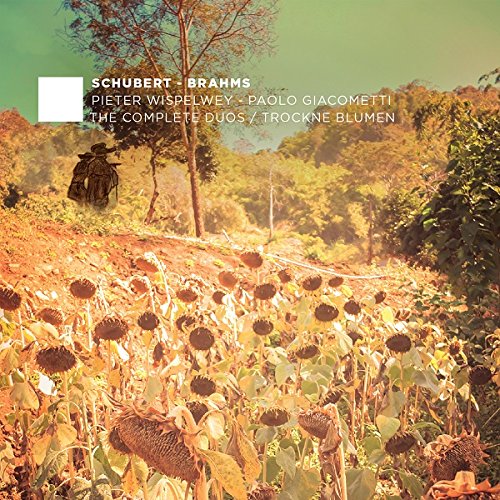SCHUBERT; BRAHMS Piano Duos. Cello Sonatas
View record and artist detailsRecord and Artist Details
Composer or Director: Franz Schubert, Johannes Brahms
Genre:
Chamber
Label: Evil Penguin
Magazine Review Date: 02/2016
Media Format: CD or Download
Media Runtime: 70
Mastering:
DDD
Catalogue Number: EPRC0021

Tracks:
| Composition | Artist Credit |
|---|---|
| Introduction and Variations (Trock'ne Blumen from |
Franz Schubert, Composer
Franz Schubert, Composer Paolo Giacometti, Piano Pieter Wispelwey, Cello |
| Sonata for Cello and Piano No. 1 |
Johannes Brahms, Composer
Johannes Brahms, Composer Paolo Giacometti, Piano Pieter Wispelwey, Cello |
| Sonata (Sonatina) for Violin and Piano |
Franz Schubert, Composer
Franz Schubert, Composer Paolo Giacometti, Piano Pieter Wispelwey, Cello |
Composer or Director: Joseph Haydn, Franz Schubert, Johannes Brahms
Genre:
Chamber
Label: Analekta
Magazine Review Date: 02/2016
Media Format: CD or Download
Media Runtime: 66
Mastering:
DDD
Catalogue Number: AN29994

Tracks:
| Composition | Artist Credit |
|---|---|
| Divertimento |
Joseph Haydn, Composer
Joseph Haydn, Composer Marie-Ève Scarfone, Piano Stéphane Tétreault, Cello |
| Sonata for Arpeggione and Piano |
Franz Schubert, Composer
Franz Schubert, Composer Marie-Ève Scarfone, Piano Stéphane Tétreault, Cello |
| Sonata for Cello and Piano No. 1 |
Johannes Brahms, Composer
Johannes Brahms, Composer Marie-Ève Scarfone, Piano Stéphane Tétreault, Cello |
Author: Charlotte Gardner
The disc’s opener is Schubert’s Introduction and Variations on ‘Trockne Blumen’, originally for flute and piano, and it makes for a striking start. Wispelwey’s top-register entry with those first despairing four notes hooks you right in, aching and vulnerable of character, with an arresting, visceral tone (incidentally, the top two strings of his 1760 Guadagnini are of uncovered gut). Indeed, as we move through the variations, there’s a lot to enjoy. But, returning to those opening bars, Wispelwey can’t reproduce the flute’s fluidity in the following semiquaver runs, and often it’s the case that what the cello brings to the work doesn’t quite compensate for the loss of the qualities bestowed on it by the flute. For instance, there’s too much obvious effort going into the smooth lines of Var 3, not helped by Wispelwey’s highly audible fingerboard action. Then, while it’s hats off to him for attempting Var 5’s demi-semiquaver sextuplets on the cello at all, even with his indisputable technical skill the unavoidable string-crossings make it impossible to achieve quicksilver cleanliness. The Sonatina in A minor, originally a violin piece, translates more smoothly, containing some lovely moments from pianist Paolo Giacometti, whose crisp, pedal-light textures contribute to the whole’s overall effect of heartfelt emotion presented with poise.
Brahms’s E minor Sonata is the disc’s one work actually intended for the cello, and Wispelwey dispatches it with his characteristic conviction and dark-hued strength. However, I couldn’t help but compare it with Stéphane Tétreault’s version. This, recorded at Quebec’s Eglise St-Augustin de Mirabel, has a refreshing absence of fingerboard percussion, which makes a particular difference in the middle movement. Also, whether this is down to Wispelwey’s interpretation or how his recording was balanced, Tétreault’s sounds more faithful to the score’s dynamic markings, meaning that in the first movement we get to appreciate a true piano start and an obvious first forte in bar 17 (at 0'45"). In fact the whole of Tétreault’s disc, which is also two-thirds arrangements but not of the news-grabbing variety, charmed me from the off; from his Haydn Divertimento (originally for the viola da gamba-like baryton), through Schubert’s A minor Arpeggione Sonata and on to the Brahms, this is just pure, lyrical, unadulterated playing of the highest order, with a maturity that belies his 22 years, and matched impeccably by his duo partner, Marie-Ève Scarfone. I can’t wait to hear more from him.
Discover the world's largest classical music catalogue with Presto Music.

Gramophone Digital Club
- Digital Edition
- Digital Archive
- Reviews Database
- Full website access
From £8.75 / month
Subscribe
Gramophone Full Club
- Print Edition
- Digital Edition
- Digital Archive
- Reviews Database
- Full website access
From £11.00 / month
Subscribe
If you are a library, university or other organisation that would be interested in an institutional subscription to Gramophone please click here for further information.




